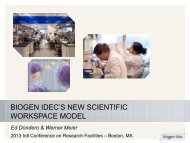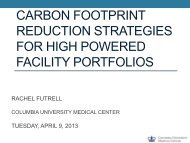Animal Research Facilities 2011 - Tradeline, Inc.
Animal Research Facilities 2011 - Tradeline, Inc.
Animal Research Facilities 2011 - Tradeline, Inc.
Create successful ePaper yourself
Turn your PDF publications into a flip-book with our unique Google optimized e-Paper software.
10<br />
Monday and Tuesday; Nov. 7-8<br />
Attend seven of the 19 Forum Sessions on Pages 10-13<br />
Space and program productivity (A-E)<br />
A. Flexibility solutions to accommodate<br />
changing research program<br />
requirements<br />
SmithGroup, <strong>Inc</strong>.<br />
Victor J. Cardona, AIA, NCARB – Vice President<br />
H. Michael Smith, AIA, LEED AP – Principal<br />
<strong>Animal</strong> research facilities now have to accommodate growing numbers<br />
of smaller, more highly focused, shorter-term research projects, a<br />
requirement that demands more vivarium capability and capacity<br />
and better space utilization. Here, Victor Cardona and Michael<br />
Smith demonstrate new decision making criteria for space allocation<br />
ratios, static and disposable caging, barrier facility designs, and<br />
biocontainment requirements. They profile facilities at Texas Tech<br />
University, UC San Francisco, Astellas, University of Louisville, and the<br />
U.S. Department of Veterans Affairs to illustrate high-performance<br />
solutions for vivariums ranging from 5,000 square feet to 60,000<br />
square feet. AIA HSW<br />
Monday 11:10 a.m. – 12:05 p.m. | Tuesday 1:45 p.m. – 2:40 p.m.<br />
B. Data based equipment and workflow<br />
decisions for lean, highly efficient<br />
vivarium operations<br />
Science Associates<br />
Jim Wallace – CEO<br />
Flad Architects<br />
Mark A. Corey, AIA – Principal<br />
This session sets out a tested and proven framework for taking<br />
animal facility operations to the next level of efficiency through the<br />
use of lean process optimization tools. Jim Wallace and Mark Corey<br />
illustrate operating plan refinements and facility design enhancements<br />
that result from vivarium specific time and motion process evaluation<br />
techniques. They examine five often overlooked operational problems<br />
and cost-effective solutions for both new construction and renovation.<br />
They draw on recent workflow assessments from facilities in the U.S.,<br />
U.K., Germany, and Italy to illustrate newly found efficiencies involving<br />
allergen control, barrier and containment operations, ergonomics, ease<br />
of maintenance, energy use, and logistics. AIA HSW<br />
Monday 1:15 p.m. – 2:10 p.m. | Tuesday 10:35 a.m. – 11:30 a.m.<br />
C. New solutions for efficient relocation<br />
and consolidation: a case study<br />
Treanor Architects, P.A.<br />
David H. Livingood, AIA, CSI – Project Management Principal<br />
McCownGordon Construction<br />
Ramin Cherafat – Vice President<br />
Kansas State University<br />
Sally A. Olson, DVM – Assistant Director, <strong>Animal</strong> Resource Facility<br />
Kansas State University took only nine months to make room for<br />
the National Bio and Agro-Defense Facility (NBAF) and completely<br />
relocate its Comparative Medicine Group Large <strong>Animal</strong> <strong>Research</strong><br />
Center. The big takeaways here relate to maintaining operations<br />
during moves and relocations, the extreme compression of project<br />
execution, successfully controlling changes during construction, and<br />
the consolidation results achieved in terms of program capability and<br />
flexibility. Session leaders set out details on the planning and project<br />
management models, metrics on costs and time, and the achieved<br />
occupancy and operating results. AIA HSW<br />
Monday 1:15 p.m. – 2:10 p.m.<br />
D. Five-year plans for animal research<br />
programs and facilities: capacity,<br />
capability, and space utilization metrics<br />
Jacobs Consultancy, <strong>Inc</strong>.<br />
Josh Meyer, RA – Managing Principal<br />
University of Washington<br />
H. Denny Liggitt, DVM, Ph.D. – Director of Comparative Medicine<br />
Kirk R. Pawlowski, AIA – Assistant Vice Provost, Capital Resource Planning<br />
Will your current vivarium facilities be able to support the big research<br />
program and equipment changes that are coming in the next five<br />
years? What are the high-priority capital investments and upgrades<br />
that are now recommended to anticipate industry changes? Here,<br />
session leaders answer those questions and detail strategies for<br />
reconciling program growth forecasts, species trends, existing space<br />
capability, equipment innovations, and capacity. They draw from the<br />
University of Washington’s updated animal facility master plan and<br />
feasibility study to determine the best use of limited capital for short-,<br />
mid-, and long-term planning. AIA HSW<br />
Tuesday 11:45 a.m. – 12:40 p.m.





